Abstract
Salsolinol (1-methyl-6,7-dihydroxy-1,2,3,4-tetrahydroisoquinoline), a metabolite of dopamine, may act as an endogenous neurotoxin and contribute to the etiology of Parkinson’s disease (PD). The inverse relationship between smoking and PD prompted our previous investigation and the report of protective effects of nicotine against salsolinol-induced toxicity in cultured SH-SY5Y cells (Copelandet al., Neurotox. Res. 8:289, 2005). These cells, derived from human neuroblastoma cells, express dopaminergic activity and are used as a model of nigral dopaminergic cells, the major site of pathology in PD. The purpose of the current study was to investigate whether apoptotic or antiapoptotic mechanisms were responsible for the observed effects of salsolinol and nicotine, respectively. Moreover, it was of interest to determine whether the actions of nicotine are mediated through nicotinic receptors. SH-SY5Y cells were exposed to 0.4 or 0.7 mM salsolinol with and without pretreatment in combination of 0.1 mM nicotine and 0.1 mM mecamylamine, and were exposed for 24 and 48 h. Various parameters including cell cycle perturbations (reflected in propidium iodide DNA staining); cell cycle regulator retinoblastoma protein (reflected in the Western blot), apoptosis (reflected in annexin V/propidium iodide staining followed by flow cytometry) were analyzed. Salsolinol caused an arrest of the cells in G1-phase of cell cycle and an increase in apoptotic indices, whereas pretreatment with nicotine attenuated or completely blocked the effects of salsolinol. Nicotine effects in turn, were totally blocked by mecamylamine (0.1 mM). The results suggest that apoptosis is a major mechanism for salsolinol-induced toxicity and that antiapoptotic effects of nicotine, mediated by nicotinic receptors, may play a primary role in its neuroprotective effects. Hence, nicotinic agonists in combination with other antiapoptotic agents may be of substantial benefit in at least a subpopulation of Parkinson patients.
Similar content being viewed by others
References
Bollimuntha S, M Ebadi and BB Singh (2006) TRPC1 protects human SH-SY5Y cells against salsolinol-induced cytotoxicity by inhibiting apoptosis.Brain Res. 1099, 141–149.
Chau BN and JY Wang (2003) Coordinated regulation of life and death by RB.Nat. Rev. Cancer 2, 130–138.
Copeland RL Jr, YA Leggett, YM Kanaan, RE Taylor and Y Tizabi (2005) Neuroprotective effects of nicotine against salsolinol-induced cytotoxicity: implications for Parkinson’s disease.Neurotox. Res. 8, 289–293.
Dasgupta P, J Padmanabhan and S Chellappan (2006) Rb function in the apoptosis and senescence of non-neuronal and neuronal cells: role in oncogenesis.Curr. Mol. Med. 7, 719–729.
Ebadi M and RF Pfeffer (2005)Parkinson’s Disease, 1st Edition (Taylor and Francis: London).
Lanzi C, G Cassinelli, G Cuccuru, R Supino, V Zuco, C Ferlini, G Scambia and F Zunino (2001) Cell cycle checkpoint efficiency and cellular response to paclitaxel in prostate cancer cells.Prostate 48, 254–264.
Lukas RJ, SA Norman and L Lucero (1993) Characterization of nicotinic acetylcholine receptors expressed by cells of the SH-SY5Y human neuroblastoma clone line.Mol. Cell. Neurosci. 4, 1–12.
Maruyama W, H Yi, T Takahashi, S Shimazu, H Ohde, F Yoneda, K Iwasa and M Naoi (2004) Neuroprotective function ofR-(−)-1-(benzufuran-2-yl)-2-propylaminopentane, [R-(−)-BPAP], against apoptosis induced byN-methyl(R)salsolinol, an endogenous dopaminergic neurotoxin, in human dopaminergic neuroblastoma SH-SY5Y cells.Life Sci. 75, 107–117.
Naoi M and W Maruyama (2001) Future of neuroprotection in Parkinson’s disease.Parkinsonism Relat. Disord. 8, 139–145.
Naoi M, W Maruyama and GM Nagy (2004) Dopamine-derived salsolinol derivatives as endogenous monoamine oxidase inhibitors: occurrence, metabolism and function in human brains.Neurotoxicology 25, 193–204.
Plasencia C, R Dayam, Q Wang, J Pinski, TR Burke Jr, DI Quinn and N Neamati (2005) Discovery and preclinical evaluation of a novel class of small-molecule compounds in hormone-dependent and-independent cancer cell lines.Mol. Cancer Ther. 4, 1105–1113.
Quik M, T Bordia and JM McIntosh (2004) Loss of α-conotoxin MII- and A85380-sensitive nicotinic receptors in Parkinson’s disease striatum.J. Neurochem. 88, 668–679.
Seo M, Y Kim, YI Lee, SY Kim, YM Ahn, UG Kang, MS Roh, YS Kim and YS Juhnn (2006) Membrane depolarization stimulates the proliferation of SH-SY5Y human neuroblastoma cells by increasing retinoblastoma protein (RB) phosphorylation through the activation of cyclin-dependent kinase 2 (Cdk2).Neurosci. Lett. 404, 87–92.
Storch A, S Ott, Y Hwang, R Ortmann, A Hein, S Frenzel, K Matsubara, S Ohta, H Wolf and J Schwarz (2002) Selective dopaminergic neurotoxicity of isoquinoline derivatives related to Parkinson’s disease: studies using heterologous expression systems of the dopamine transporter.Biochem. Pharmacol. 63, 909–920.
Tatton NA (2000) Increased caspase 3 and Bax immunoreactivity accompany nuclear GAPDH translocation and neuronal apoptosis in Parkinson’s disease.Exp. Neurol. 166, 29–43.
Thompson CB (1995) Apoptosis in the pathogenesis and treatment of disease.Science 267, 1456–1462.
Tizabi Y, KF Manaye and RE Taylor (2005) Nicotine blocks ethanol-induced apoptosis in primary cultures of rat cerebral cortical and cerebellar granule cells.Neurotox. Res. 7, 319–322.
Toborek M, KW Son, A Pudelko, K King-Pospisil, E Wylegala and A Malecki (2007) ERK 1/2 signaling pathway is involved in nicotine-mediated neuroprotection in spinal cord neurons.J. Cell. Biochem. 100(2), 279–292 [Epub ahead of print, 2006].
Weinberg RA (1995) The retinoblastoma protein and cell cycle control.Cell 81, 323–330.
Yi H, Y Akao, W Maruyama, K Chen, J Shih and M Naoi (2006) Type A monoamine oxidase is the target of an endogenous dopaminergic neurotoxin,N-methyl(R)salsolinol, leading to apoptosis in SH-SY5Y cells.J. Neurochem. 96, 541–549.
Author information
Authors and Affiliations
Corresponding author
Rights and permissions
About this article
Cite this article
Copeland, R.L., Das, J.R., Kanaan, Y.M. et al. Antiapoptotic effects of nicotine in its protection against salsolinol-induced cytotoxicity. neurotox res 12, 61–69 (2007). https://doi.org/10.1007/BF03033901
Received:
Revised:
Issue Date:
DOI: https://doi.org/10.1007/BF03033901




